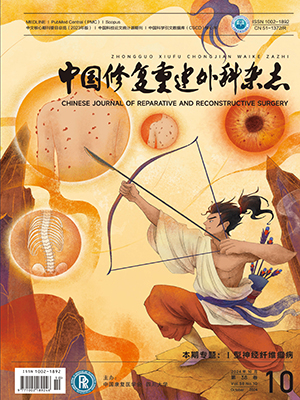| 1. |
Kaeding CC, Léger-St-Jean B, Magnussen RA. Epidemiology and diagnosis of anterior cruciate ligament injuries. Clin Sports Med, 2017, 36(1): 1-8.
|
| 2. |
Boden BP, Dean GS, Feagin JA, et al. Mechanisms of anterior cruciate ligament injury. Orthopedics, 2000, 23(6): 573-578.
|
| 3. |
Andernord D, Desai N, Björnsson H, et al. Predictors of contralateral anterior cruciate ligament reconstruction: a cohort study of 9061 patients with 5-year follow-up. Am J Sports Med, 2015, 43(2): 295-302.
|
| 4. |
Louboutin H, Debarge R, Richou J, et al. Osteoarthritis in patients with anterior cruciate ligament rupture: a review of risk factors. Knee, 2009, 16(4): 239-244.
|
| 5. |
Dragoo JL, Braun HJ, Durham JL, et al. Incidence and risk factors for injuries to the anterior cruciate ligament in National Collegiate Athletic Association football: data from the 2004-2005 through 2008-2009 National Collegiate Athletic Association Injury Surveillance System. Am J Sports Med, 2012, 40(5): 990-995.
|
| 6. |
Alentorn-Geli E, Myer GD, Silvers HJ, et al. Prevention of non-contact anterior cruciate ligament injuries in soccer players. Part 1: Mechanisms of injury and underlying risk factors. Knee Surg Sports Traumatol Arthrosc, 2009, 17(7): 705-729.
|
| 7. |
Cronström A, Tengman E, Häger CK. Return to sports: A risky business? A systematic review with meta-analysis of risk factors for graft rupture following ACL reconstruction. Sports Med, 2023, 53(1): 91-110.
|
| 8. |
De Sousa Filho PGT, Marques AC, Pereira LS, et al. Analysis of posterior tibial slope as risk factor to anterior cruciate ligament tear. Rev Bras Ortop (Sao Paulo), 2021, 56(1): 47-52.
|
| 9. |
Colyer S, Miles JJ, Crump FJ, et al. Association between biological maturation and anterior cruciate ligament injury risk factors during cutting. J Sports Med Phys Fitness, 2022, 62(8): 1078-1087.
|
| 10. |
Bisciotti GN, Chamari K, Cena E, et al. Anterior cruciate ligament injury risk factors in football. J Sports Med Phys Fitness, 2019, 59(10): 1724-1738.
|
| 11. |
Webb JM, Salmon LJ, Leclerc E, et al. Posterior tibial slope and further anterior cruciate ligament injuries in the anterior cruciate ligament-reconstructed patient. Am J Sports Med, 2013, 41(12): 2800-2804.
|
| 12. |
Lipps DB, Wilson AM, Ashton-Miller JA, et al. Evaluation of different methods for measuring lateral tibial slope using magnetic resonance imaging. Am J Sports Med, 2012, 40(12): 2731-2736.
|
| 13. |
Hashemi J, Chandrashekar N, Mansouri H, et al. Shallow medial tibial plateau and steep medial and lateral tibial slopes: new risk factors for anterior cruciate ligament injuries. Am J Sports Med, 2010, 38(1): 54-62.
|
| 14. |
Nazzal EM, Zsidai B, Pujol O, et al. Considerations of the posterior tibial slope in anterior cruciate ligament reconstruction: A scoping review. Curr Rev Musculoskelet Med, 2022, 15(4): 291-299.
|
| 15. |
Hiranaka Y, Muratsu H, Tsubosaka M, et al. Influence of posterior tibial slope on sagittal knee alignment with comparing contralateral knees of anterior cruciate ligament injured patients to healthy knees. Sci Rep, 2022, 12(1): 14071. doi: 10.1038/s41598-022-18442-y.
|
| 16. |
Alaia MJ, Kaplan DJ, Mannino BJ, et al. Tibial sagittal slope in anterior cruciate ligament injury and treatment. J Am Acad Orthop Surg, 2021, 29(21): e1045-e1056.
|
| 17. |
Hendrix ST, Barrett AM, Chrea B, et al. Relationship between posterior-inferior tibial slope and bilateral noncontact ACL injury. Orthopedics, 2017, 40(1): e136-e140.
|
| 18. |
Grassi A, Pizza N, Zambon Bertoja J, et al. Higher risk of contralateral anterior cruciate ligament (ACL) injury within 2 years after ACL reconstruction in under-18-year-old patients with steep tibial plateau slope. Knee Surg Sports Traumatol Arthrosc, 2021, 29(6): 1690-1700.
|
| 19. |
Salmon LJ, Heath E, Akrawi H, et al. 20-year outcomes of anterior cruciate ligament reconstruction with hamstring tendon autograft: the catastrophic effect of age and posterior tibial slope. Am J Sports Med, 2018, 46(3): 531-543.
|
| 20. |
Cristiani R, Forssblad M, Edman G, et al. Age, time from injury to surgery and hop performance after primary ACLR affect the risk of contralateral ACLR. Knee Surg Sports Traumatol Arthrosc, 2022, 30(5): 1828-1835.
|
| 21. |
Di Benedetto P, Buttironi MM, Mancuso F, et al. Anterior cruciate ligament reconstruction: the role of lateral posterior tibial slope as a potential risk factor for failure. Acta Biomed, 2020, 91(14-S): e2020024. doi: 10.23750/abm.v91i14-S.10996.
|
| 22. |
Hewett TE, Zazulak BT, Myer GD. Effects of the menstrual cycle on anterior cruciate ligament injury risk: a systematic review. Am J Sports Med, 2007, 35(4): 659-668.
|
| 23. |
Motohashi M. Profile of bilateral anterior cruciate ligament injuries: a retrospective follow-up study. J Orthop Surg (Hong Kong), 2004, 12(2): 210-215.
|
| 24. |
Beynnon BD, Hall JS, Sturnick DR, et al. Increased slope of the lateral tibial plateau subchondral bone is associated with greater risk of noncontact ACL injury in females but not in males: a prospective cohort study with a nested, matched case-control analysis. Am J Sports Med, 2014, 42(5): 1039-1048.
|
| 25. |
Bernhardson AS, Aman ZS, Dornan GJ, et al. Tibial slope and its effect on force in anterior cruciate ligament grafts: anterior cruciate ligament force increases linearly as posterior tibial slope increases. Am J Sports Med, 2019, 47(2): 296-302.
|
| 26. |
Lee JA, Koh YG, Kim PS, et al. Biomechanical effect of tibial slope on the stability of medial unicompartmental knee arthroplasty in posterior cruciate ligament-deficient knees. Bone Joint Res, 2020, 9(9): 593-600.
|
| 27. |
Shelburne KB, Kim HJ, Sterett WI, et al. Effect of posterior tibial slope on knee biomechanics during functional activity. J Orthop Res, 2011, 29(2): 223-231.
|




